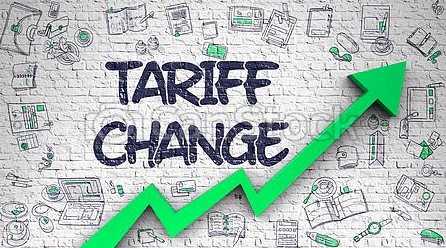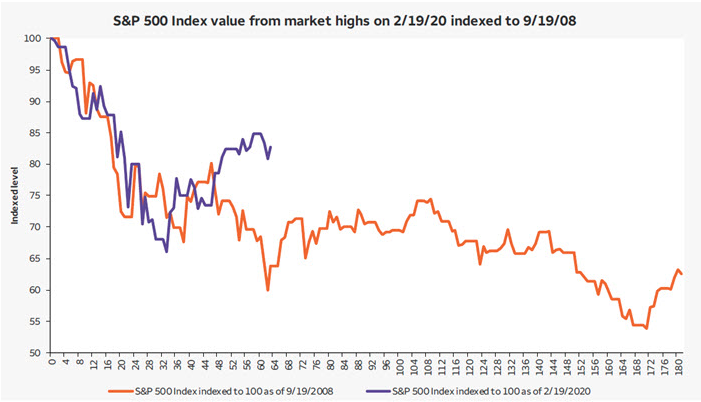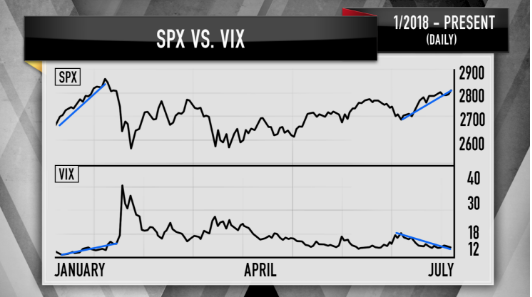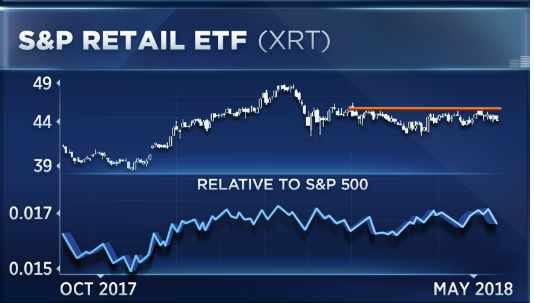So, you’re thinking about shorting UVXY/TVIX/VXX/VIXY/etc.? Or selling calls on UVXY/VXX? If so, please be advised that these types of trades have “undefined risk,” meaning that you could potentially lose not only everything in your brokerage account, but you could end up owing your broker even more money than you actually possess. All it would take is a large and sustained spike in the VIX, which is a rare event nowadays but is not out of the realm of possibility.
Fortunately, there are ways to change your “undefined” (unlimited) risk into a “defined” (limited) risk with a known maximum loss. These are strategies you’ll want to consider before you place the trade, not afterwards (especially if the trade starts to get out of control).

If you’re short-selling shares of UVXY/TVIX/VXX/VIXY/etc., the best protection (not necessarily a “hedge” but nonetheless a good precautionary measure) is to keep plenty of “liquidity” (cash) in your trading account. I would advise keeping at least 50% of your trading account in cash (or at least something that you can quickly and easily sell for cash) when placing this type of trade. This cash should be fully available to you at a moment’s notice and should be recognized by your broker as available trading capital. If you can raise the cash portion to more than 50%, that’s even better. An additional hedging strategy, if you’re short-selling 100 shares of UVXY or VXX, would be to buy a protective out-of-the-money call option (this is similar to buying a protective put option after purchasing 100 shares of a stock, as it limits your risk).
If you’re selling calls on UVXY/VXX, keeping at least 50% of your trading account in cash is also recommended. In addition, you can create a vertical spread by buying calls on the same underlying ETP, with the same expiration date, but with a higher strike price. Alternatively, you can sell vertical put spreads on SVXY.
Speaking of SVXY, you can quite effectively hedge your risk by buying SVXY or XIV instead of shorting UVXY/TVIX/VXX/VIXY/etc. Sure, you won’t necessarily have the same profit potential, but that’s the price we must pay if we want to sleep soundly at night, knowing that our maximum loss is limited to whatever capital we invested in SVXY or XIV.
If options are your preference to buying ETP’s outright, then you might consider buying debit put spreads on VXX or UVXY, or call spreads on SVXY. These can be vertical spreads, calendar spreads, diagonal spreads… You’ve got a number of choices in the wide world of options.
Yet another way to hedge one’s short VOL product position is by purchasing protective puts or calls. One example of this method would be to buy 100 shares of SVXY and an out-of-the-money put option; another example would be to short 100 shares of UVXY/VXX and buy an out-of-the-money call option.
One method that I don’t personally use in my trading is “pairs trading,” such as shorting UVXY and then buying shares of SDS, SPXU, SPXS, SDOW, etc., as an offsetting trade. If you can make this method work for you, then that’s fine, but be aware that you’ll be tying up a lot of capital by buying all of those shares; besides, your purpose should be to take advantage of the inherent decay of leveraged ETP’s, not to be a victim of it.

Last, but not least, is a perennially popular method of hedging: stop-losses. While I’m not entirely against using this method, please be aware that the VIX can ram right through your stop-loss overnight while your broker is closed and midnight traders are gleefully shorting ES futures. There’s nothing quite like waking up to a spike in UVXY/TVIX/etc. that has gapped above your utterly ineffectual stop-loss, so don’t be lulled into thinking of stop-losses as a perfect safety net.
Whichever method you use to hedge your short vol product position, always weigh your potential risk and reward and adjust accordingly. You’ll be glad you did… especially if a trade goes against you, which will always happen sooner or later.











Great, and necessary article. Thanks!
I have enough gray hair now that I want to keep a focus on hedging.
Many articles about trading vol products but not about hedging them.
One point not made is that you can get a higher Sharpe ratio by just trading ZIV or shorting VXZ. Sure the absolute return is not as good but the risk adjusted return is better, and that means you may have a better chance of holding onto your gains.
As for pairs trading, I am following one strategy of rotation of the pair of ZIV and short TBT, at a ratio depending on the VIX regime, and also the TYVIX to VIX spread. So, if the signal is risk on, then it would be 80% ZIV and 20% short TBT. Maximum risk off would be the inverse relationship. This can also be done with VXZ put spreads and TBT put spreads. VXZ is less than ideal though, due to liquidity. TMV can also be substituted for TBT, and it is more potent as a hedge.
With options, the biggest risk is liquidity IMO, because if you have to exit a position in a crisis like Aug 2015 you are going to experience some terrible slippage with the likes of VXZ or SVXY. Even UVXY can be hard to get a fill. So, in the sense of liquidity, VXX is the safest way to go, because it is by far the most liquid.
Thank you for your insightful comments, Scott. I don’t focus on VIZ and VXZ as much as the other vol products, but perhaps I should take a closer look at them, along with the pairs trading rotation strategy you described.
Scott, similarly i am trying Long VXX and Short VXZ in 1:3 ratio in paper account.. Its interesting but not yet promising… However, i do like trying the Spxu/VXX to try as well..the struggle could be the right correlation..